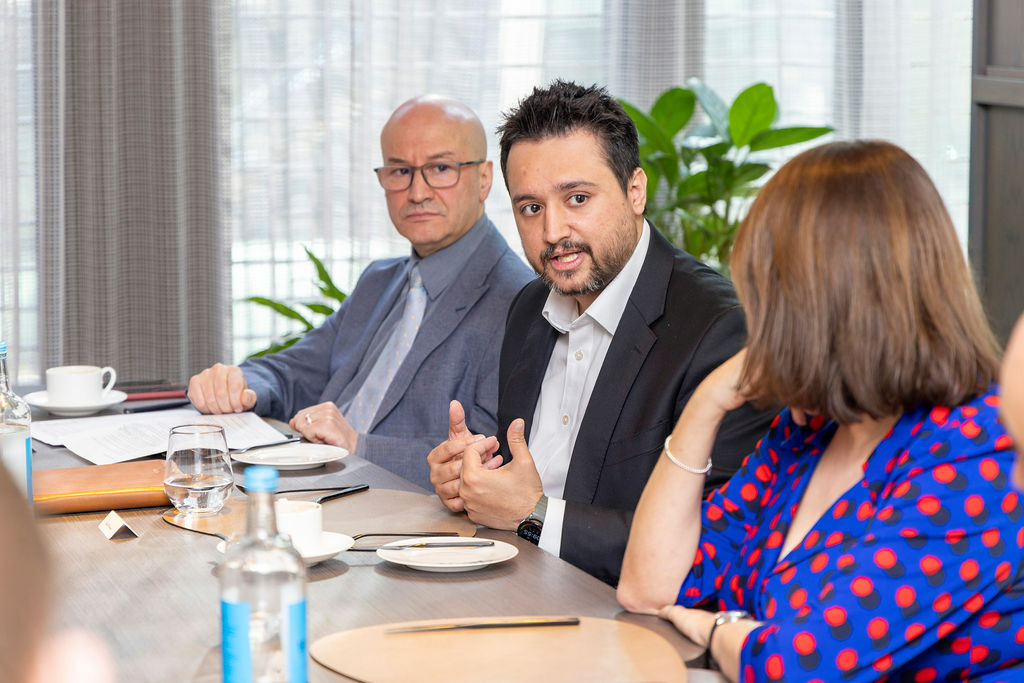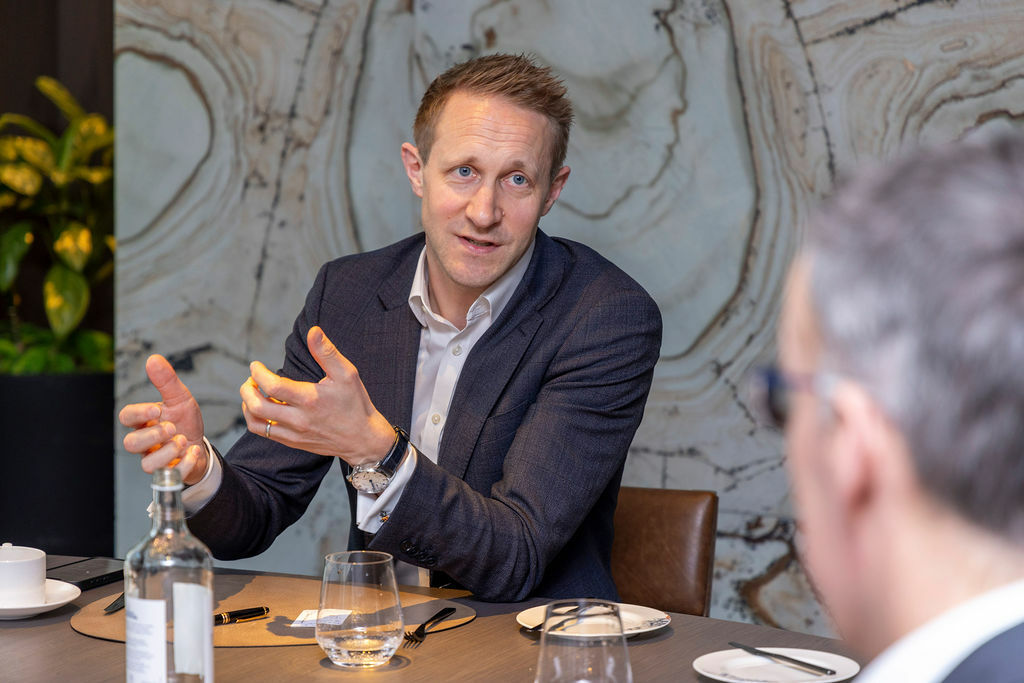
From left: Skanska UK head of pensions Mohsin Harhara; Russell Investments fiduciary manager and client CIO Aqib Merchant; Zedra Governance client director Payam Kazemian; Capital Cranfield professional trustee Michele Hirons Wood; Pi Partnership accredited professional trustee Mike Weston; Russell Investments head of UK fiduciary management Simon Partridge; Cambridge Colleges’ Federated Pension Scheme chairman Robin Ellison; Independent Governance Group trustee director Tim Giles; and PP editor Jonathan Stapleton.
At the end of March, Professional Pensions assembled a panel of experts to discuss the issue of surplus extraction and run-on.
The roundtable – chaired by PP editor Jonathan Stapleton and held in association with Russell Investments – looked at the extent to which schemes are choosing run-on/off as an endgame strategy or are wanting to explore the possibility of extracting surplus.
It looked at how defined benefit (DB) investment strategy should change depending on the endgame options chosen – assessing the implications of each choice, how best to implement such strategies, and the role of fiduciary/OCIO managers.
Panellists also discussed the types of assets that might be considered for a longer-term run-on strategy and asked if private markets could form part of the investment mix.
To what extent are schemes now looking to run‑on and to remain invested for longer rather than looking at other options?
Tim Giles (Independent Governance Group): There are still a number of schemes that are pursuing buyout and buy‑in as well as some that have actively decided to run-on for the longer-term. There are others that are running on with an eye to what they might do in the future, but are committed for a timescale of five to 10 years. And then there are a lot of schemes that do not know exactly where they are headed, but are prepared to continue as they are for the current time.
Michele Hirons-Wood (Capital Cranfield): Some companies are looking at it, and we are seeing quite a lot of approaches from sponsors that are thinking about it. Trustees are a bit more nervous, but scale comes into it and the larger schemes that have found themselves in a well‑funded position are thinking about it more.
Saying that, I am not sure that many schemes are thinking this will be an enduring, multi‑decade, run‑on strategy – it is more about realising now may not the right time to do a risk transfer and asking what the next five to ten years looks like.
It may also require some trustees to start thinking differently, so that might take some time, and covenant will be a particular concern around for some trustees. It is interesting times with mixed views, but possibly not that advanced yet.
Payam Kazemian (Zedra Governance): I agree it is very size dependent. For schemes that are less than £100m-£200m in size, it might not make sense for them to think about this because of the covenant risk, the costs and the size of the company. This idea opens up for schemes of over £200m-£500m in size, and there it can potentially make a lot more sense.
Mike Weston (Pi Partnership): Size is clearly an issue because then it is all about the costs of running the scheme. There is clearly a tipping point but, to me, it depends on the trustee board. As you say, it was not that long ago when our sole objective was getting to technical provisions (TP) full funding, and that was it. Suddenly the game has moved on – now we are over TP, so what do we do next? We do need to take an active review of all the options and make an active decision on what is going to be right for the members.
Tim Giles: I agree with Payam that the costs are not ultimately scalable – you reach a point at which, in order to meet the ongoing expenses of running the scheme, scale is an issue. There is a size at which it is not cost‑effective to continue.
Michele Hirons-Wood: It is not just about the assets and there are a couple of other things that trustees will be worried about. Firstly, finance directors (FDs) are still nervous. You also have operational and stewardship risks – for instance, cyber is an ever increasing risk, and you keep those risks if you are running on. Look at the Section 37 Virgin Media case. When is the next one of those going to happen? When trustees are considering whether they are actively running on or not, it is not purely done through an investment lens. They are also looking at what the other risks may be, and these may become more dominant.
Mohsin Harhara (Skanska): I am sensing a change, with schemes, particularly at the larger end of the scale, waiting to see what impending regulations hold in store in terms of ways of freeing up surpluses and this will incentivise both trustees and sponsors to consider run-on. There are many schemes though that are at one minute to midnight in terms of their journey to buyout. And, while we have talked about the view of trustees, there is often also pressure from sponsors in terms of risk reduction being a big priority and them being keen to remove the pension liabilities from the balance sheet.
Robin Ellison (Cambridge Colleges' Federated Pension Scheme): I am in the middle of an exercise at the moment with one charity scheme, which had been considering a journey to buyout. The sponsor is now looking at whether the alternatives would be a better use of donors' money than insurance and is looking at run-on very closely. As trustees, we are neutral about it, but the sponsor has done a lot of thinking about this.
Tim Giles: I understand that some people are concerned about the profit margins of insurers, but equally, insurers are running large risks around these things, and I am not sure this is always taken account of. Naturally, they are making profits, but you also need to understand all the risks they are taking. They are running tail risks around things like mortality, markets, margins and collateral. I do not think we should assume they are just sitting there gently racking up the money.
Aqib Merchant (Russell Investments): The choice between run‑on and insurance is not necessarily a binary one. You could be running on to eventually move to an insurer when the pricing is right or the scheme matures enough. There is always that option as well. You can run‑on for a few years and do what you want in terms of surplus generation, or let the price come to you and then move to the insurance market.

How should DB investment strategy change should a scheme decide to run‑on?
Aqib Merchant: The question is what is the objective? Why are you trying to generate the surplus? Is it to enhance benefits for DB members and pass money back to the sponsor or is it to pay DC contributions? These reasons drive how you invest your assets. For instance, if there is a desire to generate more cash flows to meet DC contributions, then you are thinking about infrastructure, about real assets, and those can be attractive asset classes to invest in as a long‑term investor.
Mike Weston: Conceptually, I have a two‑portfolio model in that there are a lot of things to de‑risk so, for me, I want a buyout portfolio that is above TP. Keep some risk in it so you get to the solvency level, but essentially, that is a de‑risked portfolio. Then there is a second, legally separate, higher-risk portfolio, maybe on the structure of a contingent asset, that sits outside this and can be used to enhance member benefits or generate surpluses.

Given that plans change over time, what assets could you consider for a run‑on strategy?
Aqib Merchant: We think a lot about the semi‑liquid options, so you invest in unlisted infrastructure or private credit. These investments have an initial lock‑up, so you are locking up for a few years, but then it gives you liquidity after that so that if scenarios change – if for instance, a finance director changes or insurance pricing gets more attractive – then you can exit those illiquids in the market.
Tim Giles: Is there going to be a big difference between how an insurer and a pension scheme in run-on would invest? Are insurers versus pension schemes fundamentally different?
Aqib Merchant: Insurers obviously have restrictions on what type of illiquids they can invest in. It is much easier for pension schemes to invest in a wide range of illiquids. That is where the distinguishing factor comes as things stand with matching adjustment and whatnot.
Tim Giles: If that is the case, it is back to this thing around the profit motives of the insurers. If pension schemes can invest more efficiently, economically, it should make more sense for them to do so.
Mohsin Harhara: Liquidity is going to be key because schemes are going to need to be agile so that if conditions change – for instance, if the employer covenant deteriorates or employer attitude changes – then they can switch to insurer‑friendly assets in readiness for buyout. I also think a strategy should be looking to target around gilts + 1 to 2% depending on specific circumstances using a portfolio that is 100% hedging the buyout funding level.
Tim Giles: That makes sense. The problem that worries me about that is there is an option premium in liquidity. If I am there for five or 10 years, I can buy private credit, which I know is going to run‑off over time. I know it is going to get better returns than the liquid alternatives. Why would I give up on the option premium just in case?
Simon Partridge (Russell Investments): Diversification is a consideration as pension schemes are increasingly becoming quite concentrated in UK government bonds and UK corporate bonds – and certain markets, particular the market for UK corporate bonds, are very heavily concentrated with pension scheme investors. We definitely take a global approach when we are building cashflow-driven investment (CDI) portfolios for exactly that reason.
Aqib Merchant: UK corporate bonds are just 5% of the global universe and if all pension schemes want to target that 5% then that is a huge concentration of risk. If you open the gate to a global approach, there are so many more options out there helping mitigate the concentration of risk.

Does buyout still remain a gold standard for members and from a trustee perspective?
Tim Giles: The gold standard piece is still used a lot. Possibly it is, from a covenant perspective, a way of buying into an insurance regime which may be stronger than most corporate covenants. I get that but is it a gold standard for administration? Is it gold standard for member flexibility?
Michele Hirons-Wood: Many members do not necessarily feel that an insurance company is gold-standard. It depends upon each scheme but many members have an emotional attachment to the company that they worked for and some members do not like the thought of leaving their company that has looked after them all their years.
Payam Kazemian: I agree. Whenever we get any negative member feedback after a buy‑in, usually there are comments from some of these members saying that the employer is "washing their hands off the pension scheme".
We have talked about run‑on and the sort of assets you might invest in but how do you best implement such a strategy? Can a outsourced chief investment officer (OCIO) and fiduciary manager help with this?
Simon Partridge: Yes. A lot of what we have talked about is flexibility, nimbleness, being able to adjust portfolios and being able to work in that collaborative sense. I know several people around this table work in a sole‑trustee type of arrangement, and that can align itself very neatly with a fiduciary management, OCIO‑type of investment mandate, to ensure that the experts are taking care of different parts of a portfolio.
For years, there has been this talk about does fiduciary management have a place, as you approach endgame – with some arguing it is just about managing some cash flows and some LDI. It is a bit more complicated than that, and we saw particularly in 2022 with the gilts crisis that it was very involved for trustees, particularly those who did not have that fiduciary manager oversight.
I think the key question is, when a scheme is moving from endgame into buyout or is in a run‑on, run‑off type of approach, who is managing all those different allocations and the cash flows? Who is making sure that the investments are properly diversified and taking a lot of that hassle factor away from trustees and everyone else?

What are your key takeaways or concluding comments from this discussion?
Tim Giles: Run‑on is a viable and a vibrant part of what we can do with pension schemes at the moment. As we have shown through this discussion – wide‑ranging as it has been – there are many things to talk about. It has to be in the members' interest. It is about making better economic use of the capital available and it is about managing the risks and the costs involved. Ultimately, it is going to be part of what we do.
Robin Ellison: I had not realised quite how many options there were that people were thinking about and the extent to which trustees and sponsors were delaying decisions while they come to terms with the markets and the regulatory environment. There will be a range of new things coming to market in the near future – watching briefs are clearly important.
Mohsin Harhara: Run‑on is going to become more prolific as time goes by – it is a viable and good option for many schemes and I wish we had had this discussion five years ago! The sense is that the government also wants to move fast with its proposals, particularly in terms of investing in the UK economy, but I am concerned that they do not make this mandatory – trustees need to have the whole investment sphere at their disposal and be given the choice.
Michele Hirons-Wood: I have always felt that run‑on was a sensible option but the one thing that trustees need to do is to look at all their options. They also need to look at run-on through multiple different lenses if they decide to do that, because, in consultation with discussions with the sponsor, they need to understand what is in it for their members and be able to demonstrate what will happen if things do not turn out as expected. They should spend time thinking about this – it is a big strategic decision, even if it is only for 10 years, and the quality of that conversation needs to be high around a trustee board.
Payam Kazemian: It is important to recognise we are lucky to have these run-on and other options to talk about and that the government is involved and wants to be creative about it. There is definitely room for run‑on, but it has to be, as was mentioned, for the right scheme and considered, proportionate and well thought through.
Mike Weston: Options have a value so I am genuinely pleased we now have a situation where trustees are considering options and have moved away from the default of simply saying ‘we are fully funded and are going to buyout'. If trustees do this right – consider the options and the risks – there could be an opportunity here to add significant value to both members and sponsors.
Aqib Merchant: For me, this marks an exciting time ahead for this industry. From our perspective, run-on needs to be an active decision, whichever option trustee boards go for, and then they need to think about what the best governance option is to manage the risks associated with whatever option they are selecting. Whether it is investment risk, whether it is funding risk, covenant risk, it is making sure everyone is talking to each other on that journey, whichever endgame option they select.
Simon Partridge: It has been a fascinating discussion. There have always been options, but these are now becoming clearer for trustees and for companies as well. Despite this, I am yet to see many firm decisions yet being taken. Maybe those decisions will flow in the coming months and years, but it is important, when deciding on whatever the next phase is or that long‑term objective is, to bear in mind that things can change. Circumstances can change. We talked about financial directors changing. We talked about how a company could be bought, sold, or get into difficulty. Being flexible, being able to change, and not locking up assets into things that cannot be got out of for 20 years, is one key part of this discussion, as is being nimble and being flexible.
This roundtable was held on 20 March 2025 in association with Russell Investments






